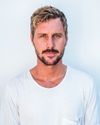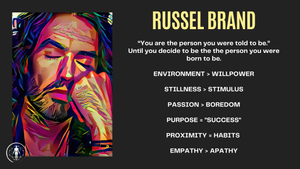AM I ADDICTED TO FEELING BAD?
Russel Brand knows a lot about addiction. His acting and comedic wit led him to fame and fortune. Along the way, he succumbed to more than one addiction; alcohol, heroin, sex, food, and even technology. Now he is using connection and spirituality to continue to beat his addictions.
Addiction is much more than a personal choice; it is guided by the modern-day reality and symptoms of a disconnected world that we have unwittingly co-created for each other; dragging along the baggage from our upbringing while we try to conform to the cultural environments of modern life. Brand remarks, “You are the person you were told to be.”
In his book, he reveals how to overcome addiction and truly recover. That it is not about avoiding pain; after all that we resist persists. Allowing yourself to feel pain, to stop and feel the emotion, might actually be the internal driver that pivots any human being back into alignment, inner peace, and living in harmony with their internal and external world.
Russel brand found a community and support in Alcoholics Anonymous and their 12 Steps program. He began to crave real connection; internally with himself, with others, with humanity, and even a deeper spiritual connection to the source of it all. To awaken this connection he had to disengage from the isolation of watching mind-numbing TV and technology devices. He found that meditation stilled his mind and created space to really feel and re-examine old narratives and memories, learning from them and releasing them from his negative mindset to create a new, positive future narrative.
Stillness in his mind let him really feel, finding bliss in everyday moments without the need for mind-altering substances. Brand’s story shows us all how we can deconstruct our mental roadblocks and realign internally, discovering the right energy and behaviors that move us up the health spectrum.
THE RAT PARK EXPERIMENT
To shine the light on the power of the environment on your behaviors and lifestyle choices, I will share some insights from the “Rat Park” experiment as it explores addiction.2 Now addiction is relative. You might not be addicted to mind-altering substances, tobacco, sugar or other vices. But you may be addicted to a lifestyle that doesn’t make you happy, addicted to work, and even addicted to technology and the dopamine hits you get from social media. It’s a simple experiment that you could do at home (but I wouldn’t recommend it for reasons that will soon become apparent).
If you get a rat and you put it in a cage and you give it two water bottles: one bottle of clean water and the other water bottle laced with morphine. If you do that, the rat will almost always prefer the drugged water and almost always kill itself quite quickly. So there you go, right? That’s how we think addiction works.
We have been taught that there are chemical hooks. This means that if you took “the chemical hook” for a period of time, your body would become dependent on them and you would biologically need them and become an addict, right? If you smoked one cigarette, you wouldn’t be able to stop. If you take recreational drugs you wouldn’t be able to control them. If you ate a lot of sugar or drank alcohol, you would get diabetes and become a sugar addict or an alcoholic. Many of us may have had an accident, ended up in a hospital, and taken opioids, but the vast majority aren’t addicted to the synthetic chemicals that numb our pain. But what if the pain was necessary, something to be felt and embraced; not something to be suppressed and numbed? Perhaps this modern approach to suppressing pain, rather than embracing its signal in our life is the real issue.
What if everything we have learned about addiction from a chemical and biological standpoint is wrong. What if the effect and addiction of choice were simply just a response to stress, boredom, suppressed emotions, and environments that never really served us? Would it mean that rather than looking at the chemicals and behavioral addictions, we looked at what role the environment played? This is where the Rat Park experiment gets interesting.
WHAT IF IT WASN'T ABOUT ADDICTION, BUT THE ENVIRONMENT?
In the 1970s Professor Bruce Alexander looked at this experiment and he noticed something interesting. He noticed that the rats were being put in an empty cage. The rats had nothing to do, except use drugs. Imagine living like a rat in a cage, isolated, disconnected, stressed, and bored. I’m sure you would seek mind-altering substances to warp your reality too. Consider how caged animals in a zoo become depressed and the whales and dolphins in the sea parks who have been known to try and take their own lives.
Professor Bruce Alexander suggested something a bit different. He built a cage that he called “rat park,” which is basically a heaven for rats: loads of space, cheese, and activities. Rat park includes an array of tunnels, exercise wheels, and most importantly—loads of friends, and they can even have lots of sex. Now the kicker is that the rats were given drugged water for 57 days in a row and then released into rat park. In rat park, they still have access to both the water bottles, the normal water, and the drugged water. Considering the first experiment. What do you think happened next?
In the rat park, something interesting happened. They didn’t use the drugged water. None of the rats used it compulsively. None of them ever overdosed. They preferred to get on with life in the rat park.
What this shows is that the rats went from almost a hundred percent strike- rate of overdosing when isolated and caged, to zero percent overdosing when they lived in a happy, connected, and nourishing environment.
Coming out of the 2020–21 “pandemic” makes you consider whether isolation, disconnection, and removing people from their activities was the right response for good health.
“Lack of support is one of the number one things my patients complain about. I’ve seen, firsthand, how social isolation can manifest into illness. Studies show that isolation can set off a cellular chain reaction that increases inflammation and suppresses the body’s immune response to disease," said changemaker Radha Agrawal
In his TED talk, journalist Johann Hari asked: “What if addiction is an adaptation to your current environment?”4 He shared that a professor called Peter Cohen in the Netherlands said that maybe we shouldn’t even call it an addiction. Maybe we should call it bonding.
Human beings have a natural and innate need to bond. And when we’re happy and healthy we’ll bond and connect. But it’s harder to do that when you’re traumatized or isolated or beaten down by life, often you will bond with something else, something that will inevitably give you a sense of relief. Now that might be painkillers, gambling, or pornography. That might be cocaine or cannabis, but you will bond and connect with something because that’s human nature. Perhaps we need to create nourishing environments and stop focusing on the vice itself so that people don’t need to escape their current reality.
PREVENTION IS THE LIFESTYLE CURE
AGEING FORMULA
Self Harm = Rate of degeneration > Rate of Regeneration
SelfCare = Rate of Regeneration = Rate of Degeneration
Self Mastery = Rate of degeneration < Rate of Regeneration
I am confident by now that you have embraced the life-changing impetus of this book that simply adopting a holistically healthy lifestyle can prevent 80% of chronic diseases.
This truth is slowly pervading modern society however according to Yale-Griffin PRC Director David Katz, MD, overall the general public lacks clear and consistent advice about the role of lifestyle medicine in promoting health. He says too many competing voices, capitalist-driven motives, and conflicting messages in the media have left many people confused about how best to improve their health.
To overcome this confusion and educate the public about lifestyle medicine, Dr. Katz assembled a global coalition called the “True Health Initiative.” It consists of over 300 leading experts and influential leaders from the paradigms of the 12 Medicines; Nature, Environment, Connection, Food, Modern medicine, Lifestyle, and many more.
These health experts collated their knowledge about lifestyle as medicine and agreed on 6 core principles of healthy living that could add years to lives, and life to years:
8 ways to MINIMISE SELF-HARM & OPTIMISE SELF-CARE
- Consuming minimally processed, low human interference mostly plant-based foods;
- Avoiding toxins such as tobacco and excess alcohol;
- Move more and rest well
- Adopting a physically active lifestyle;
- Getting plenty of sleep;
- Find harmony in your work and lifestyle
- Reducing psychological stress;
- Cultivating supportive relationships and social bonds.
HOW TO BE DISEASE PROOF
It sometimes seems as if everyone around us is being diagnosed with a chronic illness—and that we might soon join them. Leading specialist in preventive medicine Dr. David Katz draws upon the latest scientific evidence and decades of clinical experience to explain how we can slash our risk of every major chronic disease—heart disease, cancer, stroke, diabetes, dementia, and obesity—by an astounding 80%. by making lasting lifestyle changes is easier than we think.
We don't have a 'health' care system; we have a disease-care system. To get from here, to there, we need a revolution. From passive healthcare to empowered SelfCare, supported by enabling communities and nourishing natural environments.
HOW TO ADD 14 YEARS TO YOUR LIFE
Four simple health behaviors may cut our risk of chronic disease by nearly 80%, potentially dropping our risk of dying equivalent to that of being 14 years younger.
In 1903 Thomas Edison predicted that “[t]he doctor of the future [would] give no medicine, but [would instead] instruct [their] patient in the care of [the] human frame in diet and in the cause and prevention of disease[s].”
“An impressive number of studies have shown that lifestyle is the root cause of what ails us.” The good news, though, is that by changing our lifestyle, we can dramatically improve our health. We have the power.
For most leading causes of death, we’ve long known that our genes account for, at most,10 to 20% of the risk, given the fact that rates of killers like heart disease and major cancers differ up to a hundred-fold among various populations, and that when people “migrate from low-[risk] to high-risk countries, their disease rates almost always change to those of the new environment.” For example, at least 70% of strokes and colon cancer are avoidable; “over 80%” of coronary heart disease; “over 90%” of type 2 diabetes, avoidable.
STOP
BY “Adhering to [just] 4 simple healthy lifestyle factors can have a strong impact on the prevention of chronic diseases.”
1. Not smoking,
2. Not being obese,
3. Half-hour of exercise a day,
4. Eating healthier—Eat more plants; more fruits, veggies, whole grains, and less meat.
Four simple things cut our risk of developing a chronic disease by 78%. 95% of disease risk, is out the window; 80% of the heart-attack risk, is gone. Half of stroke risk, a third of cancer risk; are simply gone. Think of what that means, in terms of the numbers. As it stands now, each year a million Americans experience their first heart attack or stroke; a million get diabetes; a million get cancer.
SWAP
These “Three cardinal lifestyle behaviors exerted an enormous impact on mortality.”
People “who do not smoke, consume a healthy diet, and engage in sufficient physical activity can substantially reduce their risk [of] early death.”
1. By not smoking, they just meant “not currently smoking.”
2. By “healthy diet,” they just meant in the top 40% in terms of complying with the rather wimpy federal dietary guidelines of 2 fruits, 5 vegetables each day, and hydration.
3. By “Physically active” meant averaging about 21 minutes a day, or more, of at least moderate exercise. Those who managed at least one of the three had a 40% lower risk of dying.
MODERATE
Those that hit two out of three cut their chances of dying by more than half.
Those who scored all three flushed 82% of their chances of dying in those six years down the drain.
The drop in mortality risk in those nailing all four healthy behaviors “was equivalent to being 14 [years] younger.” It’s like turning back the clock 14 years. Turns out that like the French, you can have your cake and eat it too!
SUMMARY
FOCUS ON HEALTHY LIVING > DEATH and DYING
Rather than taking health advice from doctors who are overweight, or countries where their burden of chronic preventable disease outweighs healthy individuals by 2-10x! Maybe we should look somewhere else.
Longevity hotspots, centenarians, and global blue zone communities share 9 core rituals to living a healthy life. They offer a unique perspective by focussing on how to live vibrantly, rather than focusing on death and disease. It's refreshing to focus on the solution, rather than the problem.
REFERENCES
This is directly referenced from the best-selling Amazon SelfCare Book "Lifestyle Medicine For the People" by Rory Callaghan. If you would like to read more content like this. Grab the free online chapters of the book or a hard copy.
We have done our best to reference everyone’s expert opinions, peer-reviewed science, and original thoughts, all references available here and referenced in the text.
We also understand that most thoughts are not our own and there is a collective unconsciousness, unconsciousness, and universal mind stream of energy that is always at work. Ho



